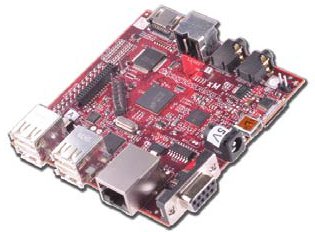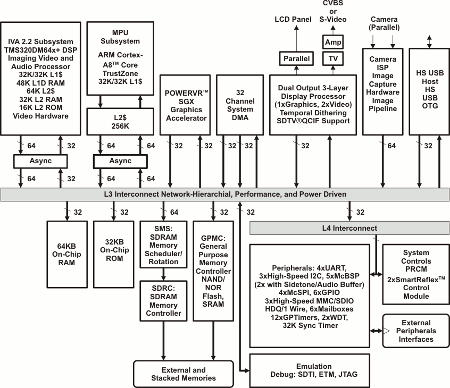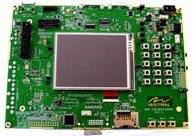TI launches 720p-ready Cortex-A8 SoC
Aug 16, 2010 — by Eric Brown — from the LinuxDevices Archive — 50 viewsTexas Instruments announced two 720p video-ready ARM Cortex-A8 SoCs (system-on-chips) it says are up to 50 percent faster than the popular OMAP35xx, while using 40 percent less power. The DaVinci DM3730 uses a 1GHz Cortex-A8 core, a 800MHz C64x+ DSP core, and a 3D graphics accelerator, while the DaVinci DM3725 model is similar except for the 3D support.
The DM37xx SoCs target applications requiring "half-HD" video processing, and are suitable for mobile devices, says Texas Instruments (TI). Applications are said to include navigation systems, media players, medical-patient monitoring devices, industrial test and measurement devices, industrial vision, and portable communications.
An evaluation module and BSP are currently offered for Linux and Android (the latter via Mentor Graphics), while Windows CE support will be available from Adeneo in the fourth quarter, says the company. RTOS versions are also under development by various vendors, says TI.
The DM3730 came to light shortly before TI announced the similar AM3715 and AM3703 SoCs in early June. In late May, BeagleBoard.org spilled the beans by announcing the new version of its Digi-Key sold, open source OMAP3x "BeagleBoard" development board. The popular, Linux-driven development board has previously run TI's 600MHz or 720MHz Cortex-A8-based OMAP3530 SoCs, which are built with 65nm fabrication techniques.

BeagleBoard-xM
According to TI, the DM3730 is essentially identical to the 1GHz Sitara AM3715, except for the addition of a video accelerator. In essence, the video- and 3D-accelerated DM3730 is to the AM3715 what the (similarly video- and 3D-accelerated) OMAP3530 was to the 3D-only OMAP3515. The DM3725 meanwhile, assumes the role of the OMAP3525, which has accelerated video, but no 3D.
The DM37x processors are software-compatible with the OMAP35xx SoCs and pin-compatible with Sitara AM37xx devices, says TI. Compared to the OMAP3530, the DM3730 offers a 50 percent increase in ARM performance, a 40 percent increase in DSP performance, and double the graphics performance, claims TI. At the same time, it is said to consume 40 percent less power.
The DM3730 improves performance over the OMAP3530 with 45nm fabrication, as well as more Level 1 cache, and a faster frequency for its SDR controller, according to TI DaVinci Marketing Manager Juan Gonzales, who briefed us on the device. As with the OMAP3530, the SoC also offers an ARM Neon instruction set multimedia co-processor.

DM3730 block diagram
(Click to enlarge)
The DM3730 features a faster 800MHz C64x+ DSP (digital signal processor) up from 520MHz on the OMAP3530, Combined with a hardware imaging and video accelerator (IVA), and the included audio and video codecs, the DSP enables 720p video and audio decoding, claims TI. By comparison, the OMAP3530 was limited to D1 video for the most part, and offered 720p only on MPEG4 and in an unstable state, said Gonzales.
I/O for the DM3730 and DM3725 appears to be identical to that of the AM3715, which made some substantial improvements over the OMAP35xx interface line-up. All three SoCs offer an LCD video display subsystem and a camera interface subsystem, says TI.
Major interfaces include USB OTG and Host interfaces, five serial ports, four McSPI serial ports, and three I2C controllers, says TI. Other I/O is said to include MMC/SD, as well as UARTs and GPIO.
No Ethernet support appears to be provided, but as the new BeagleBoard-XM shows, designers can work around that by offering Ethernet via USB.
For more information on the DM37xx, please see our more detailed coverage of the similar Sitara AM37xx SoCs, here, or check out the datasheets in the links at the end of the story.
DaVinci DSP programming gets easier
The DSP engine in the DM37xx SoC is more programmable than ever, said Gonzales. The DM37xx SDK now ships with a royalty-free library of DSP-optimized signal processing algorithms accessible from the ARM processor via a set of "easy-to-use" application programming interfaces (APIs), he added.
The DSP library is said to contain more than 80 algorithms, including multimedia decoders and encoders, math functions, digital filtering including Fast Fourier Transform (FFT), and image processing including image filtering and analysis. Examples include an edge-detection algorithm for a camera-enabled industrial application that can detect the presence or absence of people or objects, says the company.
"Our regular DSP customers were fine with our earlier development support, but our ARM-centric customers found the existing DSP tools challenging, so we added the new API support," said Gonzales.
Gonzales added, "Now, users can write a C program and use our 200 DSP kernels like they would with an ARM library. We also offer a richer set of demos, a GUI interface, and a wider array of tools to help get them started. This will enable them to get up and running quickly without having to learn for new set of tools."
TMDXEVM3730 EVM and Linux BSP
 TI offers a software development kit (SDK) for an evaluation module, the TMDXEVM3730 EVM (pictured), that supports either a DM3730 or Sitara AM37xx SoC. The module is said to include a TI Bluetooth/Wi-Fi module and a touchscreen LCD.
TI offers a software development kit (SDK) for an evaluation module, the TMDXEVM3730 EVM (pictured), that supports either a DM3730 or Sitara AM37xx SoC. The module is said to include a TI Bluetooth/Wi-Fi module and a touchscreen LCD.
The SDK offers a Linux kernel 2.6.32 board support package (BSP) complete with graphical user interface, graphics, applications, demonstrations, and development utilities, says TI. Also included are the DSP APIs and tools noted above. As previously mentioned, Mentor Graphics is offering an Android BSP, and Adeneo is working on the Windows CE version for later this year.
The DM3730 is also available for the BeagleBoard-xM (see image farther above). When this open source development board shipped earlier this summer, it was made available with an AM3715, which can be swapped out for the DM3730.
The Linux-ready, $179 BeagleBoard-xM ups memory to 512MB, boots from external media, and offers on-board Ethernet and a four-port USB 2.0 hub, among other enhancements.
Availability
The DM3730 and TMDXEVM3730 evaluation module are available now. The DM3730 is sampling, and will be available in production quantities at some unstated date starting at $25.60 in 1,000 unit quantities. The EVM module is available now for $1,495.
Support for the Linux and Android operating systems is available today, and Windows CE support will be available in the fourth quarter, according to TI.
The BeagleBoard-xM open-source community board, meanwhile, is available from Digi-Key with the DM3730 for $179.
More information on the DM3730 may be found here, and a detailed DM3730 datasheet may be found here. The DM3725 datasheet may be found here. More information on the AM/DM37x evaluation module should be here.
This article was originally published on LinuxDevices.com and has been donated to the open source community by QuinStreet Inc. Please visit LinuxToday.com for up-to-date news and articles about Linux and open source.